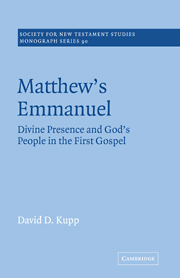Book contents
- Frontmatter
- Contents
- Preface
- List of abbreviations
- 1 Introduction
- 2 Matthew's narrative art
- 3 Reading Matthew's story of divine presence
- 4 Paradigms of presence in the Old Testament
- 5 ‘I am with you’: the Old Testament tradition of the saying
- 6 Matthew 1: the birth of the ‘God-with-us’ Messiah
- 7 Matthew 18.1–20: the presence of Jesus and his έκκλησία
- 8 Matthew 28.16–20: the presence of the risen Jesus
- 9 Jesus' presence and Matthew's christology
- 10 Conclusion
- Bibliography
- Index of passages
- Index of authors
6 - Matthew 1: the birth of the ‘God-with-us’ Messiah
Published online by Cambridge University Press: 19 January 2010
- Frontmatter
- Contents
- Preface
- List of abbreviations
- 1 Introduction
- 2 Matthew's narrative art
- 3 Reading Matthew's story of divine presence
- 4 Paradigms of presence in the Old Testament
- 5 ‘I am with you’: the Old Testament tradition of the saying
- 6 Matthew 1: the birth of the ‘God-with-us’ Messiah
- 7 Matthew 18.1–20: the presence of Jesus and his έκκλησία
- 8 Matthew 28.16–20: the presence of the risen Jesus
- 9 Jesus' presence and Matthew's christology
- 10 Conclusion
- Bibliography
- Index of passages
- Index of authors
Summary
The conclusions above in Chapters 2 and 3 about the rhetorical function of Matthew's presence motif resulted from applying to the text that particular set of questions which treat it as a narrative story. In Chapters 4 and 5 we looked at the presence motif via another set of questions concerning its place historically and theologically in the OT scriptures and traditions Matthew valued so highly. Having seen the importance of the patterns of presence and the divine ‘with you’ language of the OT we are able here to return to Matthew, to take a closer look at the evangelist's redactional artwork in Matthew 1,18 and 28, and at the particular christology which inspired his composition. If the exercise in Chapters 2 and 3 was closer to reading and interpretation à la Krieger's ‘mirror’, the following conforms more to his ‘window’. However, we want to employ compositional and redactional evidence here to complement our narrative reading of the Gospel; we are not reading the Gospel in order to find historical evidence for the purpose of hypothetical reconstruction. The central concern of this chapter is the composition of the Matthew 1 birth story around Jesus' christological significance.
Tradition and redaction
Any investigation of Matthew's infancy narrative which turns to the secondary literature can quickly become overwhelmed by the centuries-old preponderance of interest in issues of patriarchy, παρθένος, and procreation sans partner. Commentary on the Emmanuel naming has often come as a secondary appendage to these discussions.
- Type
- Chapter
- Information
- Matthew's EmmanuelDivine Presence and God's People in the First Gospel, pp. 157 - 175Publisher: Cambridge University PressPrint publication year: 1996



